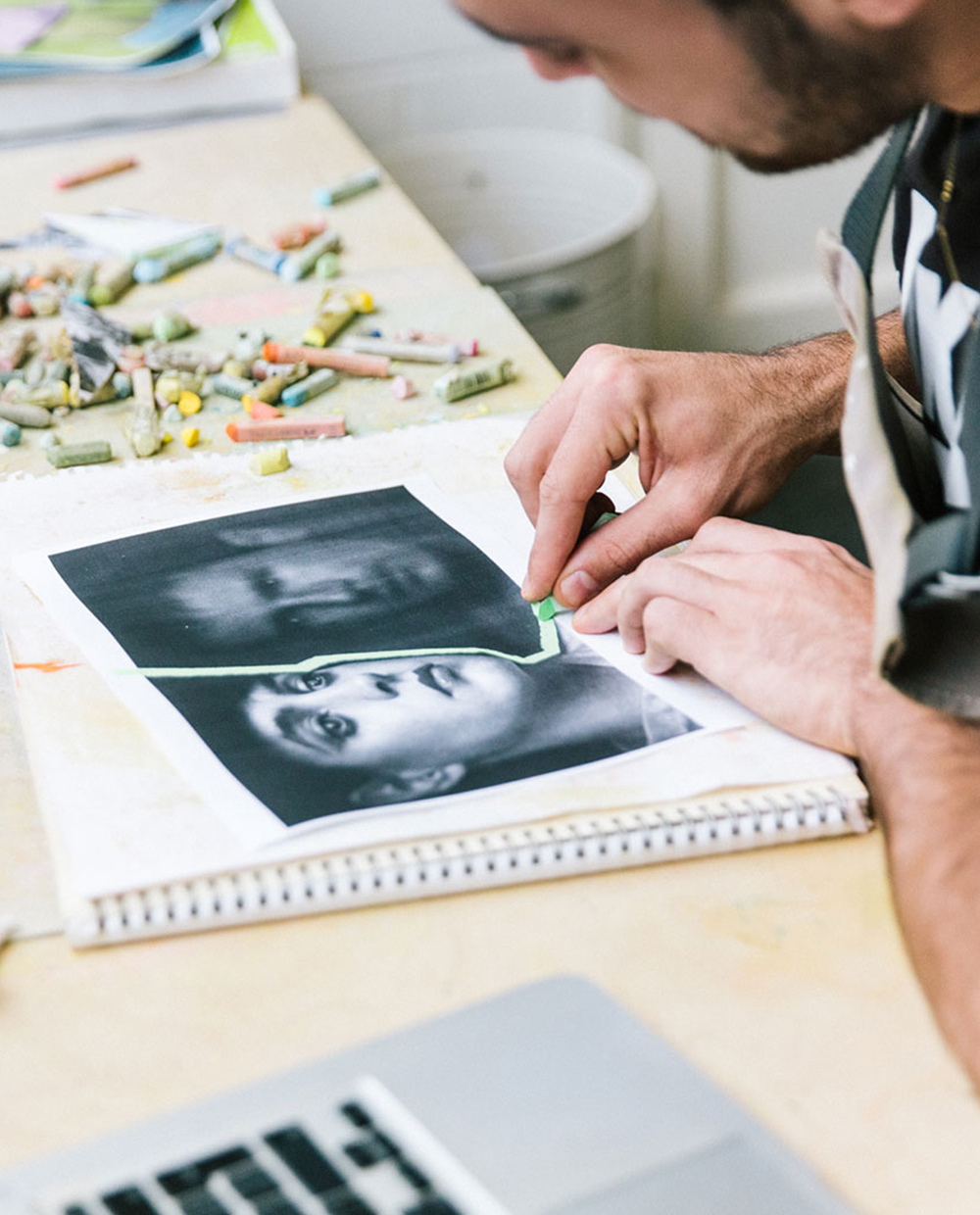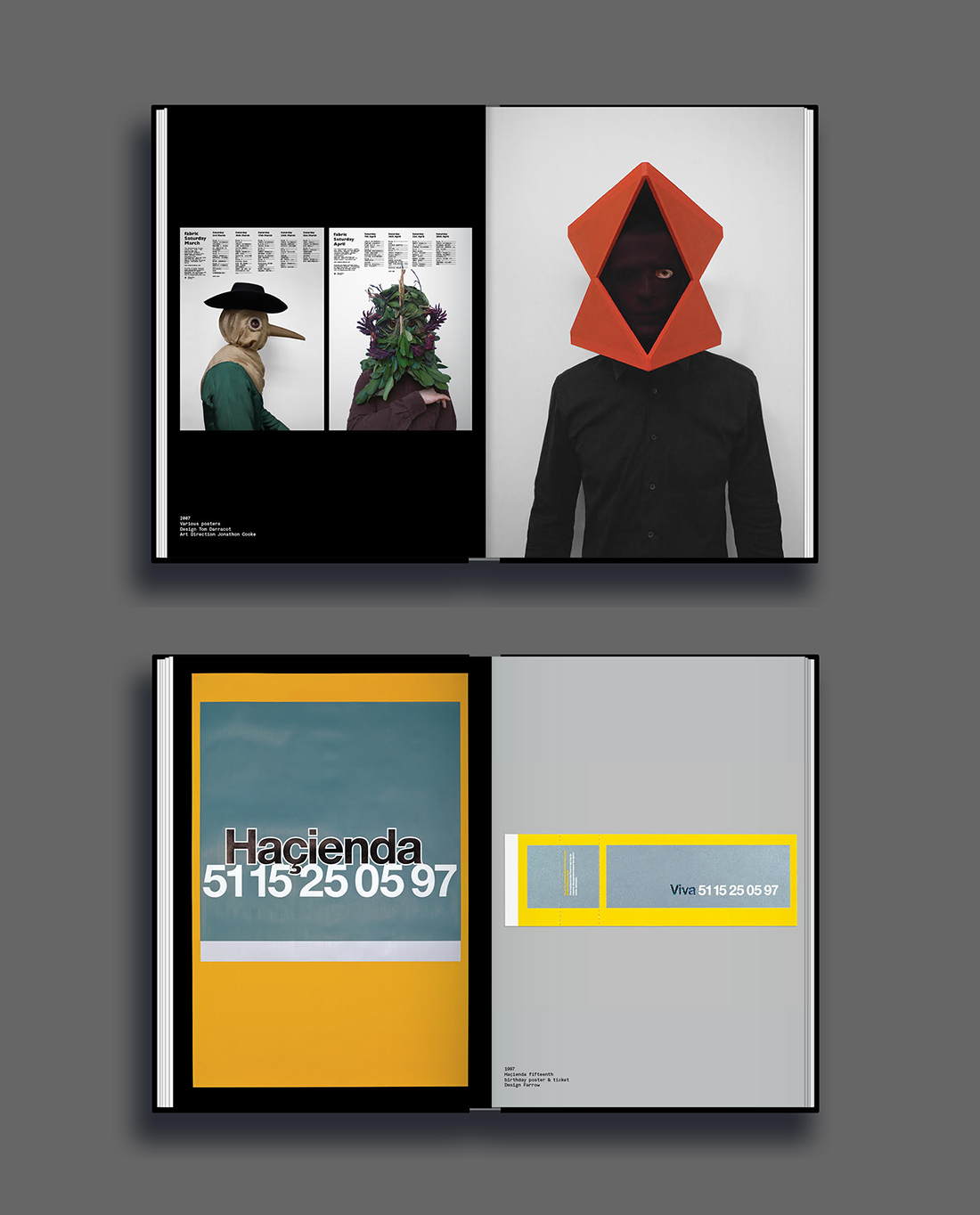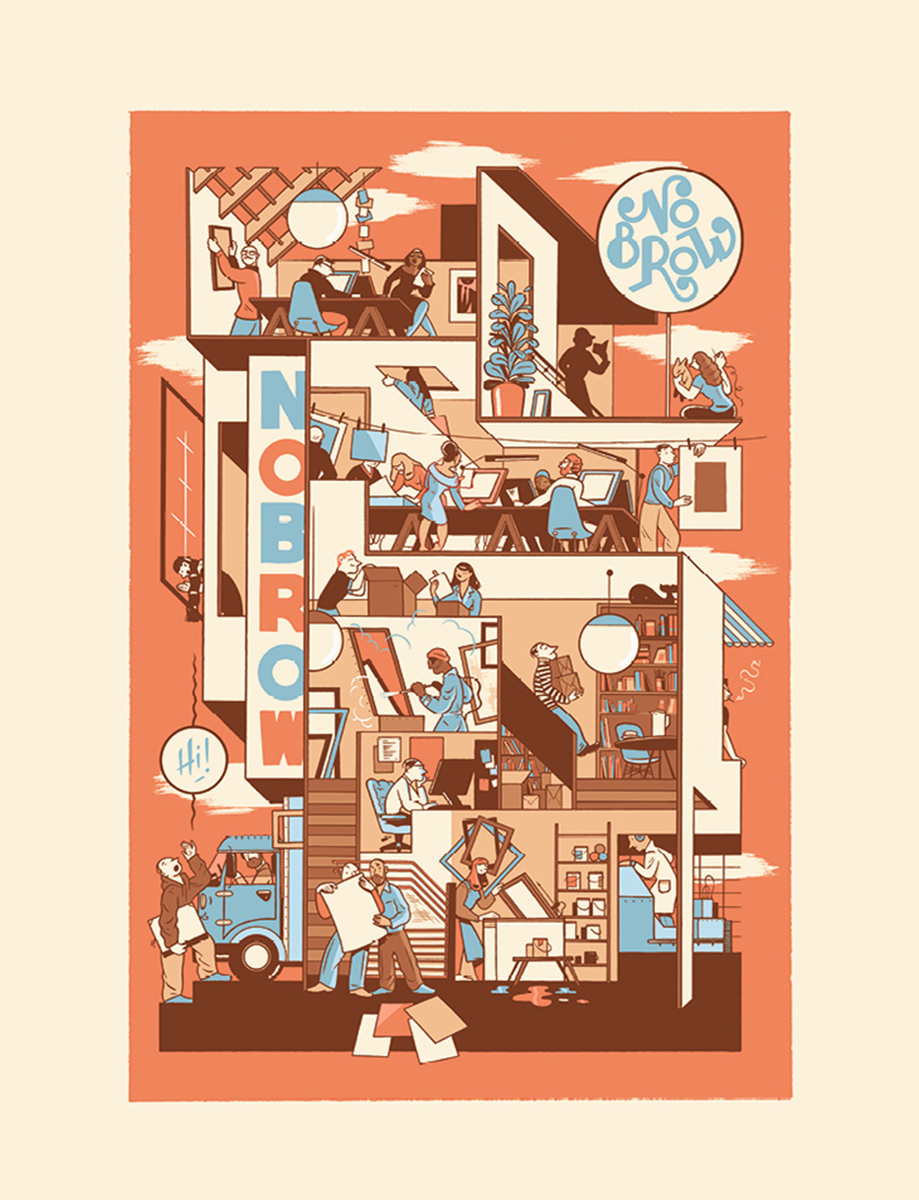There’s an element of formalism to his process and at no point do his resulting pieces ever feel over-embellished. By isolating and emboldening shapes, he elevates elements of each image, breathing new life into existing work. Yet he’s not the sort of artist who would enjoy labels being foisted upon him. The way Joe works is instinctive and usually not the result of a predetermined or rigorous process. Images reveal themselves to him, and he uses his artistic sensitivity to navigate through the creative process.
We met with Joe at his studio in London to get a better sense of who he is, and what he does.

What’s your name? Where do you come from? What do you do?
My name is Joe Cruz. I’m an artist and also a commercial illustrator. I was born in North London but all my family are from different places; one nan is French, one granddad is Spanish, my other nan is Austrian and my other granddad is English. They all came to London and from there we moved to Hertfordshire as a family.
I did my foundation course in Cambridge and then studied BA Fashion and Illustration at Norwich. Mainly specialising in printmaking, doing lots of life drawing and using the library and stuff. Then after uni I knew I wanted to be an artist, so I carried on going… and here we are! I initially worked lots of part-time jobs for four or five years ‘til art became a sustainable career. That’s pretty much how I got to where I am.
As a little kid, I always liked to arrange things and be in control.
Can you remember the first moment you were captured by the arts?
I don’t know specifically – none of my family are really into art but I’ve always loved drawing, even in, like, play-school. That’s all I was interested in at school. I’m not academic in other aspects, but I’ve always been drawing.
As a kid, I liked cartoons and fashion. Actually, always fashion in particular. In fact, even as a little kid, I always liked to arrange things and be in control; rearranging everything in my room all the time and stuff like that. So to answer your question, not really. I knew I wanted to pursue art from a really young age, and I couldn’t become a professional athlete, so that was the natural conclusion.
Did you have aspirations to be an athlete then?
Yeah, I’ve been doing karate for over 20 years and have always loved sport – loved football, loved basketball. I wanted to do something like that but then I sustained a bad knee injury and couldn’t really continue.

Did growing up in North London influence your work at all?
More than North London being an influence, the fact that all my family are from different parts of Europe has played a big part, as you get all the different influences from there. I go to Seville every summer, which is where my nan lives, and it’s always really exotic. The Moors populated the area for hundreds of years and I love the Arabic influence that you can still see there today – I definitely think that feeds into my work. See, like that piece there [gestures]. It carries a lot of the Catholic influences from that area; it’s quite camp and over the top with lots of gold. That’s definitely fed into aspects of my work. And it’s only when you look back on it that you realise that’s where it comes from.
Does sport and being active feed into your work?
Definitely. My work is really high energy, there’s lots of movement and it’s very physical and responsive. I suppose it’s not overly thought out initially, and I respond viscerally to the imagery I work with and attack it.

When you’re creating the work, is it an intuitive sense that guides you?
Definitely. The best work is when nothing’s planned and you end up making mistakes. It’s best when things naturally occur – you end up discovering new techniques and new ways of working, and that’s the aspect I really enjoy. Pushing the practice, and doing different things.
Doing the commercial side is a bit different. It pays the bills, obviously, but they want you to do the same thing over and over. I do really enjoy it but when I’m not doing commercial projects, I try to push the practice. For instance, I’m trying to develop some 3D work at the moment for a show in Tokyo. I’m always trying to push it. I get bored so quickly anyway and I can’t imagine doing the same thing over and over forever.

In an ideal world would you lose the commercial work?
Sometimes I think that.. but equally I think I’d still like to do it. Obviously in an ideal world I’d be Joe Cruz with the massive gallery shows, but even if that was the case, I’d still want to push the commercial work into a more high-end context. I’d like to do the high-end collaborations and pick and choose the brands I want to work with.
Sometimes it’s really fun to do a line of clothing, which you can’t do if you’re just focused on your own studio. I really like to see my work applied to different avenues. The only downside to the commercial aspect for me, is that you don’t always get complete creative control – the client normally has something in their head that they want. Now that I’m getting more and more established, I’m much more up front with what I want, and with taking control of the final output. I try not to hand over work that I don’t want used, as whatever gets used is a representation of me.
So is your practice collaborative at all? Looking around the studio there’s other people pottering about.
Not really, no! I sometimes work with photographers. A lot of the time I find and source photography myself but some of the time I work directly with photographers. And sometimes I work with graphic designers. I’ve always liked posters and the history of poster art. I’m always up for trying things.

Do the photographers ever get angry with you at all? As your work is about obscuring theirs.
Not really! Jack Davidson is one of the ones that I collaborate with most and he’s doing really fantastic work in his own right. Something about his images grabbed me; there was one image in particular that I really liked and I just used it without his permission. I posted it up on Instagram and the reaction it got was really good. Then he said, ‘That’s my image, I love it, here’s some more images!’ So I’ve never had an issue using found photography. If I know who the people are, I’ll credit them.

Are artists more afraid of taking people’s imagery nowadays?
No, if anything, less! There’s such an abundance of imagery out there – we’re seeing so much stuff all the time. I think we’re quite reckless with it. The copyright thing is such a grey area now, it’s not very linear. That’s reflective of the culture though I guess, more than the work… that idea of making instant work. Because now, more and more, you’re making the work for a screen rather than making it for a painting, because you can reach more people, so much quicker, doing it that way.
Do you approach the work differently because of this?
It is slightly different because you can be a bit more… well everything is handmade, but you don’t have to perfect the final work so much, as you would if you created a painting. All of my final works which I have over there [gestures], I scan them in and post them on Instagram.

Are you attached to the idea of mark-making from a painter’s perspective? I ask because the mark-making seems very dynamic in your work.
Everything I use is cheap really – I use the cheapest printers. The only quality item that I actually use is the pastels themselves. More expensive pastels are richer and you get nice textures. I like using rough and ready materials and creating something that’s quite primitive really. I’ve always been very interested in primitive art and creating something that’s quite raw, I guess.
I like using rough and ready materials and creating something that’s quite primitive.
To run with that – what are the inspirations that you find yourself coming back to? You mentioned primitive art and the Arabic influences from Seville, but what else inspires you?.
All sorts! Honestly, loads of different things. I’ve always liked German Expressionism and African art… things like that. Artists like Max Beckmann, Ernst Ludwig Kirchner, and then obviously I love all the 20th Century masters. But then I also love all the Renaissance artists and Pop artists. Honestly, so many different things!
Are you the sort of person who will have an obsession for a while and fixate on it?
Maybe, yeah. Who am I looking at at the moment… oh that’s it… Cy Twombly! I’d never really seen his work before and then my friend showed me his stuff. And you know when you’re familiar with something but don’t really delve deeper… it’s brilliant! All the painting, the drawing, the photography and the sculptural work – I was really impressed by all the sculptural work.
Sometimes I do fixate on an interest. The good thing is that I work at a university, so I get access to the library. It’s nice when you set projects and you force yourself… because you have to teach a new subject… you force yourself to learn about a different period in art history, and by doing that you discover more art. So that’s really important for me, to carry on discovering, otherwise it would feel stale – and I don’t want that. I pick and choose little techniques from different ideas and that way it keeps it moving forwards.

In terms of discovering the found images you work with – what’s the process behind this?
More and more now, it’s by using Tumblr and Instagram. It might be that I see a wider image and then crop into a tiny part of it – focusing on little aspects of images.
I also go through waves of using different techniques. I could go through a wave of using ink, or chalk, or doing cut-outs. Then within each technique there’ll be a structure that works with those sort of images, so I know what to look for, and can start finding images that are composed in a particular way. Then again, sometimes I’m just looking at stuff that resonates with me and my interests. It’s a bit of both. It’s balance between the two; finding a structured image with something I’m looking for, which also grabs me by the gut.

What role does colour play in your work?
I suppose I do have an emotional relationship with colour. I wouldn’t say I’m super into colour or anything like that [gestures towards outfit which is entirely black]. But it is an emotional relationship, it’s all about how I’m feeling. For example, I might find an image that resonates with something that’s happening in my personal life, and I’ll respond to it.
It’s almost like therapy. I find it reflective afterwards. And I understand more about myself after I’ve made the work.
The nice thing about the work is that it’s almost like therapy. I find it reflective afterwards. And I understand more about myself after I’ve made the work. Which is why I’m not like, ‘Oh I’m going to make this piece of work about this.’ It is more like approaching it as therapy – just to get my energy and emotions out. Then you look back and go, ‘Oh that sort of explains that.’ It’s a really nice thing to have.

How did you first establish a consistent aesthetic?
Well, at uni, I always had very different aesthetic interests and my inspirations were completely different to other people in the class, so I sort of went off on my own tangent. Like I said, a lot of classic poster art, German Expressionism, all sorts of different things really. I started to work with more printmaking and I really liked bold mark-making; I used to transfer that all onto a screen (silkscreen). So I’d have the image, some text written onto it and different marks. I wouldn’t be very structured with my screen-printing, I’d have a bunch of stuff on top of my screen and it’d be proper messy – that’s how I developed that way of working.
Then when I left uni, I didn’t have access to any way of screen-printing, it was so expensive. It could be £400 for a 3 layer screen-print, for the quantities I wanted to do. So I started to draw directly onto newspapers, and then I bought a really cheap old photocopier and started to work directly onto the photocopies. It’s got a similar aesthetic. If not even better really, because it’s so much more immediate. Rather than drawing onto tracing paper and putting it on a screen, I’m drawing directly onto it. It either works or it doesn’t, and it’s immediate, you know straight away, there’s no fiddling around.

You mentioned earlier that being athletic fed into your work, is fashion also something that’s always been present?
My nan used to own a factory in North London making garments for Vivienne Westwood and Aquascutum and all those sorts of brands. So I’ve always been interested in fashion. When I first came out of uni I tried to create a ‘fashion brand’; I did like a line of scarves and stuff like that. I just set myself a project straight away.
What was that called?
It was a Joe Cruz collection basically. I did like four or five silk scarves, which I’ve still got. I thought I’d set up my own fashion brand but it was so expensive to do it. I’ve done a lot of fashion collaborations off the back of it though. But now, more and more, I’m becoming comfortable with talking to a few of my clients who are fashion companies. I’d like to do more garments – more scarves, tapestries and things like that. It’s nice to see your work out in the world. I’d like to wear my work, but it’s colourful and I would never wear, like, a massive colourful design on a t-shirt, so it would have to be more like a pattern design, or creating a logo or motif… or it could be in the lining of a garment. Just applying it in a way that I would want to wear.
Sounds like your scarves were the perfect example!
Yeah the scarves were great. It’s just a canvas anyway. I think with the scarf you can keep it as a pure artwork, whereas with a blazer or a coat you have to be much more subtle. Like I say, I’m interested in wearing what I produce and so far that hasn’t really come about because the fashion companies want something super colourful. It’s all getting there… all the things I want to do!
What would your dream project be?
Dream project… Maybe just doing a couture fashion collaboration… and all the models’ makeup is done in my style of artwork too.







